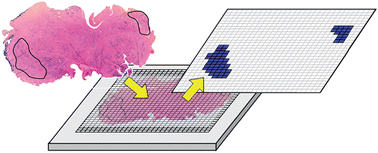2D-PCR: a method of mapping DNA in tissue sections†
Abstract
A novel approach was developed for mapping the location of target DNA in tissue sections. The method combines a high-density, multi-well plate with an innovative single-tube procedure to directly extract, amplify, and detect the DNA in parallel while maintaining the two-dimensional (2D) architecture of the tissue. A 2D map of the gene glyceraldehyde 3-phosphate dehydrogenase (GAPDH) was created from a tissue section and shown to correlate with the spatial area of the sample. It is anticipated that this approach may be easily adapted to assess the status of multiple genes within tissue sections, yielding a molecular map that directly correlates with the histology of the sample. This will provide investigators with a new tool to interrogate the molecular heterogeneity of tissue specimens.


 Please wait while we load your content...
Please wait while we load your content...